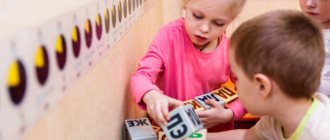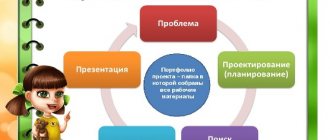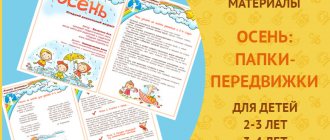Nursery
The youngest pupils are accepted into the nursery group of the kindergarten. Their age ranges from 1 year to 2-3 years. They are usually located on the ground floor; the furniture in the group corresponds to the height of the children.
Classes are provided on the development of speech, music, and the surrounding world, in accordance with the plan. Classes are conducted by a teacher in a group and last no more than 10 minutes.
Toys are also selected according to age: large cubes and pyramids, rubber animals and baby dolls, balls, cars, children's sets for playing with sand, dolls, doll dishes, baby books - all without small and dangerous parts.
The daily routine in the nursery group differs from that of older children: early breakfast, lunch, afternoon snack, dinner. Going to bed early for a quiet hour.
There should be no more than 10-15 children in such a group. The presence of a nanny is required to help dress and undress the children, feed and wash them, and put them to bed.
There is usually only one holiday - New Year, and it is also celebrated in a group.
What are the features and structure of classes in the senior group?
Activities in kindergarten are given the main place. Education for older preschoolers is carried out mostly in the form of work in subgroups. This includes classes from the cognitive cycle: preparation for mastering literacy, mathematics, familiarization with the outside world, development of musical and rhythmic abilities and artistic and productive activities.
Their peculiarities are both the conduct of the entire lesson in the form of a game, and the inclusion of various game elements in its structure. This makes it easier not only for the child to acquire the necessary knowledge, but also to consolidate it. Through play it is easier to learn how to apply them in practice, since such activities are the main ones for children of this age.
The structure of a lesson in kindergarten in the senior group is determined by its program content. It usually consists of several parts (from one to five). The amount depends on the age of the children and the nature of the tasks assigned to them.
Each part of the lesson is its structural unit and includes various methods and techniques, as well as didactic tools that are aimed at achieving a specific task.
Junior
The younger group is attended by children aged 3 to 4 years. These are more independent children who know and can do a lot.
Drawing, physical education and music lessons with specialist teachers, drawing and modeling are added to the main classes. The duration of the lesson is 15 minutes.
Children at this age love to play role-playing games, so among the toys there are various, but simple, children's sets of a doctor, a hairdresser, a builder, a cook, as well as all kinds of construction sets with large parts and figures.
Reading books may contain a longer and more detailed plot. There should also be books with riddles and simple coloring books with a simple silhouette or outline.
In the younger group, in addition to the New Year, a holiday dedicated to March 8 is often organized for children, and they are held in a large music hall.
Many children at this age already speak well, so for performances at holidays they can be given poems and small roles to memorize together with their parents.
Average
The age of children in the middle group is from 4 to 5 years. They are already more physically developed, love to play outdoor games, and acquire the first skills in using simple sports equipment (balls, hoops, skittles, gymnastic sticks, etc.). Therefore, in the middle group of kindergarten they conduct much more physical education classes and physical education minutes, including outside.
Classes such as mathematics, literacy, application, and logic are being introduced. Class duration is 20 minutes.
In many kindergartens, parents are given the opportunity to enroll their children in additional clubs - dance, English, arts and crafts, etc.
Toys and games include cubes with complex patterns for making pictures, lotto and dominoes, educational board games, as well as glove toys for acting out theatrical scenes and fairy tales. Children can now not only listen to a fairy tale to the end, but also, having memorized the roles, show it to children of younger groups.
“Autumn Festival” and “Spring Festival” are added to the main matinees.
Middle groups in kindergarten
The middle groups accept children 4-5 years old. Parents can bring their children daily from Monday to Friday from 7:00 am to 7:00 pm.
By the age of 4-5, a child is already developing as a personality. Kids know how to evaluate themselves and other children. The guys try to keep up with their peers. In addition, children can already notice individual character traits.
You can easily notice how your child tries to copy your actions. And if he has any difficulties, he tries to solve the problem on his own. The child still actively communicates with other children in the group (or even in kindergarten), actively shares his skills and gains new knowledge from his peers. All this helps the comprehensive development of the child and expands the baby’s horizons.
By the age of 4-5, the child is already practically formed. At the same time, you may notice that each child is individual: each has his own character, interests, tastes and preferences. Children at this age are quite active and mobile, they regularly make new acquaintances. Sometimes parents begin to worry when they see their son or daughter being excessively active. There is no need to worry, much less limit the child’s activity. In this case, the parent can only help the baby develop correctly, creating comfortable conditions for growing up. For example, a child must be enrolled in a kindergarten, where he fulfills all his needs by communicating with peers and teachers. And at home the child will behave calmer and more relaxed.
What main classes should be included in the middle group of kindergarten?
- getting to know the world around us (what objects surround us, what is happening around us, what “friendship” and “family” are)
- elementary mathematical processes (children learn to count from one to 10, and also learn addition and subtraction);
- speech development (children learn to retell short tales and stories, enrich their vocabulary, learn to speak correctly);
- get acquainted with literary works and authors of favorite fairy tales and stories;
- attend lessons in modeling, drawing, and design (thanks to this, the baby develops imaginative and spatial thinking);
- music lessons (children continue to become familiar with pieces of music, rhythm and tempo);
- engage in physical exercise (just 10-20 minutes of exercise will help the child develop endurance and speed). In general, at this age, sports are extremely useful for children. You can enroll your son or daughter in gymnastics or dance classes. Typically, children are happy to engage in their chosen activities and communicate with a new team. It is not so important here whether your child is the best. Here the process of training itself is beneficial. Your child will grow up healthy and confident, he will be able to achieve any goal and learn to solve any problems on his own;
What is the psychological atmosphere in the middle group?
Every parent should understand that all of the above activities should be carried out in a friendly manner. The child himself must want to do what the kindergarten program offers. Teachers should pay special attention to relationships in the children's team. It is extremely important here that children feel psychologically comfortable and cozy - this is the main condition for staying in kindergarten.
If you notice any problems in the team or any psychological pressure on the child from teachers or peers, you should think about changing kindergarten.
Today many gardens are open, both private and public. And if you are worried at any point, do not waste time, because the psychological health of your son or daughter should come first.
Older
The senior group of the kindergarten is attended by children aged 5 to 6 years. Classes are already becoming more intense, in-depth and longer – 25 minutes each.
In addition to the basic ones, classes can be held on the history of the native land and basic handicraft skills can be instilled.
Children can already perform simple exercises from sports such as gymnastics, basketball and some others.
The toys in the group should be varied and age-appropriate: mosaics, puzzles, three-dimensional construction sets with many details.
Children are also taught housekeeping skills. Therefore, among the toys there should be miniature doll gas stoves, cutlery, an ironing board with a toy iron, brooms, dustpans and brooms. You can invite children to care for indoor flowers, aquarium fish, and parrots.
“Christmas”, “Defender of the Fatherland Day”, “Easter”, “Victory Day” are added to holidays and matinees.
Age features of development of children 5–6 years old (older group)
Popova Evgenia
Age features of development of children 5–6 years old (older group)
SOCIAL-EMOTIONAL DEVELOPMENT :
A 5-6 year old child strives to know himself and another person as a representative of society, and gradually begins to realize the connections and dependencies in social behavior and relationships between people. At 5-6 years old, preschoolers make positive moral choices (mainly in the imaginary plane)
. They are beginning to use more precise vocabulary to denote moral concepts more often - polite, honest, caring, etc.
At this age, the possibility of self-regulation is formed in the behavior of preschoolers, that is, children begin to make demands on themselves that were previously placed on them by adults. This way, they can, without being distracted by more interesting things, complete unattractive work (putting away toys, tidying up the room, etc.)
.
This becomes possible thanks to children’s awareness of generally accepted norms and rules of behavior and the obligation to comply with them. The child emotionally experiences not only the assessment of his behavior by others, but also his own compliance with norms and rules, the compliance of his behavior with his moral ideas. However, compliance with norms (playing together, sharing toys, controlling aggression, etc., as a rule, at this age is possible only in interaction with those who are the most sympathetic, with friends.
At the age of 5 to 6 years, changes occur in the child’s ideas about themselves; the assessments and opinions of their comrades become significant for them. The selectivity and stability of relationships with peers increases. Children explain their preferences by the success of a particular child in the game ( “It’s interesting to play with him”
etc.) or his positive qualities (
“She’s good”
,
“He doesn’t fight”,
etc.).
Children's communication becomes less situational.
They willingly talk about what happened to them: where they were, what they saw, etc. Children listen carefully to each other, emotionally empathize with the stories of their friends. At 5-6 years old, a child develops a system of primary gender identity based on essential characteristics (feminine and masculine qualities, features of the manifestation of feelings , emotions, specific behavior, appearance, profession). When justifying their choice of peers of the opposite sex, boys rely on qualities of girls such as beauty, tenderness, affection, and girls rely on qualities such as strength and the ability to stand up for another. The life safety capabilities of a 5-6 year old child are increased. This is due to the growth of awareness and arbitrariness of behavior, overcoming the egocentric position (the child becomes able to take the position of another).
GAME ACTIVITIES:
In game interaction, joint discussion of the rules of the game begins to occupy a significant place. Children often try to control each other's actions - they indicate how this or that character should behave. In cases where conflicts arise during play, children explain their actions to their partners or criticize their actions, referring to the rules. age assign roles for play, one can sometimes observe attempts to jointly solve problems ( “Who will be?”
).
At the same time, coordination of actions and distribution of responsibilities among children most often arise during the game itself.
GENERAL MOTOR SKILLS:
Gross motor skills become more perfect: the child runs well on his toes, jumps over a rope, alternates on one leg and the other, rides a two-wheeled bicycle, skates. Complex movements appear: he can walk along a narrow bench and even step over a small obstacle; knows how to hit the ball on the ground with one hand several times in a row. Children's posture and correct manner of holding themselves are actively being formed. Endurance ( the ability to engage in physical exercise for a sufficiently long time) and strength qualities ( ability to use small efforts for a sufficiently long time) develop.
Dexterity and the development of fine motor skills are manifested in a higher degree of independence of the child during self-care: children practically do not need the help of an adult when dressing and putting on shoes. Some of them can handle laces - thread them into a shoe and tie them with a bow.
MENTAL DEVELOPMENT :
By the age of 5, they have a fairly large stock of ideas about the environment, which they receive thanks to their activity, desire to ask questions and experiment. Ideas about the basic properties of objects deepen: the child knows basic colors well and has ideas about shades (for example, he can show two shades of the same color : light red and dark red); can tell how geometric shapes differ from each other; compare the size of a large number of objects.
A 5-6 year old child knows how to make equality out of inequality; arranges 10 objects from largest to smallest and vice versa; draws geometric shapes in a checkered notebook; highlights details in objects that are similar to these figures; oriented on a sheet of paper.
Mastering time is still not perfect: not precise orientation in the seasons, days of the week (the names of those days of the week and months of the year with which significant events are associated are well learned).
Children's attention becomes more stable and voluntary. They can do a not very attractive, but necessary activity for 20-25 minutes together with an adult. A child of this age is already able to act according to the rule set by an adult (select several figures of a certain shape and color, find images of objects in the picture and shade them in a certain way).
The memory size does not change significantly. Its stability improves. At the same time, children can already use simple techniques and means to memorize (diagrams, cards or drawings can serve as hints)
.
At 5-6 years old, visual-figurative thinking takes on leading importance, which allows the child to solve more complex problems using generalized visual aids (diagrams, drawings, etc.)
. Children resort to visual and effective thinking in cases where it is difficult to identify the necessary connections without practical tests. At the same time, the tests become systematic and targeted. Tasks that can be solved without practical tests can often be solved by a child in his head.
develops , which allows the child to see the perspective of events, to foresee the near and distant consequences of his own actions and actions.
SPEECH DEVELOPMENT :
For children of this age, correct pronunciation of sounds becomes the norm. By comparing his speech with the speech of adults, a preschooler can discover his own speech deficiencies.
A child of the sixth year of life freely uses the means of intonation expressiveness: he can read poetry sadly, cheerfully or solemnly, he is able to regulate the volume of his voice and the pace of speech depending on the situation (read poetry loudly at a holiday or quietly share his secrets, etc.).
Children begin to use generalizing words, synonyms, antonyms, shades of word meaning, and ambiguous words. Children's vocabulary is actively replenished with nouns denoting the names of professions, social institutions (library, post office, supermarket, sports club, etc.)
;
verbs denoting the labor actions of people of different professions, adjectives and adverbs reflecting the quality of actions, people’s attitude towards professional activities. Uses synonyms and antonyms in speech; words denoting the materials from which objects are made (paper, wood, etc.)
.
Preschoolers can use complex cases of grammar in speech: indeclinable nouns, plural nouns in the genitive case, follow the orthoepic norms of the language; capable of sound analysis of simple three-sound words.
Children learn to independently build playful and business dialogues, mastering the rules of speech etiquette, and use direct and indirect speech; in descriptive and narrative monologues they are able to convey the state of the hero, his mood, attitude to the event, using epithets and comparisons.
The reading range of a 5-6 year old child is replenished with works of various subjects, including those related to family problems, relationships with adults, peers, and the history of the country. The baby is able to retain a large amount of information in memory; he can read continuously. The practice of analyzing texts and working with illustrations contribute to deepening the reader's experience and the formation of reader sympathies.
By the age of 6, a child can freely state his first name, last name, address, parents’ names and their professions.
MUSICAL, ARTISTIC AND PRODUCTIVE ACTIVITIES:
In the process of perceiving works of art, children emotionally respond to those works of art that convey feelings and relationships that they understand, various emotional states of people and animals, and the struggle between good and evil.
When listening to music, children show greater concentration and attentiveness. Creative manifestations of musical activity become more conscious and directed (the image and means of expression are thought through and consciously selected by the children).
In visual arts, children can also depict what they have in mind (the idea leads to the image)
.
The development of fine motor skills influences the improvement of drawing techniques: preschoolers can draw narrow and wide lines with paint (with the end of the brush and flat, draw rings, arcs, make a triple stroke from one point, mix paint on the palette to obtain light, dark and new shades, whiten the main tone to obtain a lighter shade, apply one paint to another. Children are happy to trace the drawings along the contour, shade the figures.
Older preschoolers are able to sculpt from a whole piece of clay (plasticine, modeling the shape with their fingertips, smooth out the joints, pull the parts with their fingers from the main forms, decorate your works with the help of stacks and moldings, paint them.
Practical skills in working with scissors are improved: children can cut circles from squares, ovals from rectangles, transform some geometric shapes into others: a square into several triangles, a rectangle into stripes, squares and small rectangles; create images of various objects or decorative compositions from cut-out figures.
Children design according to the conditions set by adults, but are already ready for independent creative design from different materials. Gradually, children acquire the ability to act according to a preliminary plan in design and drawing.
WORK ACTIVITY:
In older preschool age (5-7 years)
actively
developing .
Previously mastered types of child labor are performed efficiently, quickly, and consciously. It becomes possible for children to master different types of manual labor. ATTENTION - THIS IS IMPORTANT!
The age of 5-6 years can be characterized as the age when a child masters an active imagination, which begins to acquire independence, separating from and preceding practical activities. Images of the imagination reproduce reality much more completely and accurately. The child clearly begins to distinguish between the real and the imaginary. The actions of imagination - the creation and implementation of a plan - begin to take shape initially in the game. This is manifested in the fact that before the game, its concept and plot are born.
Preparatory
The preparatory group of the kindergarten is attended by children aged 6 to 7 years. For children, this is a very important, last, final stage before entering school.
There are many developmental and educational activities: reading and mathematics, native speech and the world around us, music and physical education, manual labor and origami, modeling and drawing.
The group often sets up easels and hangers with clothes from various professions for children’s story games. At this age, children are actively learning the rules of etiquette, as well as traffic rules.
Matinees and holidays are elaborate and theatrical. Children can even act as presenters. The graduation party at the end of the year is the most important for children and their parents, where graduates show all their abilities and talents.
Preparatory group in kindergartens
At 6-7 years old, children attend a preparatory group. The working hours of this group are the same as the previous ones: Monday to Friday from 7:00 am to 7:00 pm. This is the final year in kindergarten, and the next year the child already goes to school.
In the preparatory group, children prepare for school, therefore, they study literature, mathematics, reading and drawing. In addition, children become familiar with the rules of the road. Complex classes will be especially useful here.
A distinctive feature of such classes is that different types of activities are combined in one lesson. This helps the child maintain concentration longer, despite the fact that even at 6-7 years old children are quite mobile and active;
Costume theatrical performances with songs and dances are also held here. And the prom symbolizes farewell to kindergarten and the entry into a new stage of growing up.
What do children do in the preparatory group?
At this age, the child already has a daily routine in the kindergarten and children try to stick to it even when they are at home with their parents.
Approximate daily routine in the preparatory group:
- the child comes to kindergarten and changes clothes;
- while the group is gathering, the child is engaged in independent activities;
- morning exercises;
- breakfast;
- games at your own request;
- classes according to the methodological plan;
- outdoor games;
- dinner;
- dream;
- getting up, going to the toilet;
- afternoon snack;
- games at your own request;
- games and walks outside;
- dinner;
- packing home
Such a daily routine helps organize and prepare children for school preparation. At the same time, children socialize and play outside a lot, but also study literature, mathematics and writing. Children are taught what a traffic light is, how to navigate and behave correctly on the street.
Note to parents
Parents often ask the question: at what age should they send their child to school? Some people want to send their child away at 6 years old, while others think that the child should spend another 1 year in kindergarten.
Psychologists say that a child must be physically and mentally prepared to go to first grade.
If you see that your baby is still uncomfortable and unusual in leaving the kindergarten and he is only 6, then it is better to leave him in the preparatory group. If a child goes to school at age 7, he will lose absolutely nothing. In addition, this will help the child avoid psychological stress.
Age characteristics of children in the preparatory group
At 6-7 years old, every child dreams of learning something important and useful. The child rather perceives activities in the kindergarten as a game, where the child tries in every possible way to demonstrate himself and his best qualities and abilities. He especially wants to distinguish himself from others and earn praise.
You should not be silent at this time. Praise your son or daughter even if they are not doing well yet. You show him that you appreciate his efforts and successes. This is how the child develops self-esteem and healthy self-esteem.
The child's intelligence becomes noticeably higher. Ideas about the world also change and become broader.
As you can see, kindergarten plays an important role in raising a child and developing him as a person. But we should not forget that both boys and girls need regular attention and care from both the father and the mother. Both at 2 and 7 years old, tell your child how much you love him, that you are always on his side and what a great guy he is for trying.
Speech therapy
Children are recruited into speech therapy groups by a speech therapist based on preliminary testing and after a thorough examination. The ONR group includes children with general speech disorders, the FNR group includes children with problems in pronouncing certain sounds.
Pupils, in addition to the main classes, engage in special exercises with a speech therapist and teacher aimed at improving and improving their speech.
In such groups there are usually not many children - 10-12 people. Classes with a speech therapist can be individual or group, and are conducted according to a schedule. All other classes are conducted according to a simplified and facilitated plan, acceptable for children with such defects.
Summer
A summer group is usually a temporary group for the summer period, which is attended by children of different ages. There are usually no classes in the summer, but only outdoor games, reading books, going to puppet theaters or museums.
In any group of a preschool institution there must be two teachers and one nanny.
The day should be organized strictly according to the regime established for each specific age, with games, walks, activities, and entertainment. Each lesson is held no more than 2 times a week.
Does the head of a kindergarten have the right to keep a child in a group that is not according to age...
Vladimir
Send your complaint to
organization directly to the executive body of the constituent entity of the Russian Federation that carries out public administration in the field of education,
Clause 5 of the order of the Ministry of Education and Science of the Russian Federation dated April 8, 2014 No. 293 “On approval of the Procedure for admission to training in educational programs of preschool education”
it is determined that admission to a state or municipal educational organization can be denied only due to the lack of free places in it
.
If there are no places in a state or municipal educational organization, the parents (legal representatives) of the child, in order to resolve the issue of his placement in another general education organization, apply directly to the executive body of the constituent entity of the Russian Federation that carries out public administration in the field of education, or the local government body that carries out management in the field of education.
At the federal level, the procedure under consideration is regulated by Order of the Ministry of Education and Science of the Russian Federation dated April 8, 2014 No. 293 “On approval of the Procedure for admission to training in educational programs of preschool education” (hereinafter referred to as the Procedure).
Admission rules that are not regulated by federal legislation may be specified by regional and municipal acts, as well as by the rules of a specific educational organization. Moreover, these clarifications cannot worsen or limit the rights of citizens that are enshrined at the federal level.
The rules for admission to educational organizations must ensure the admission to the educational organization of all citizens who have the right to receive preschool education, in addition, also ensure the admission of citizens who have the right to receive preschool education and who live in the territory to which the specified educational organization is assigned (hereinafter referred to as the assigned territory).
The assignment of territories is carried out by issuing a regulatory act (order, instruction) of local authorities, i.e. this is the municipal level of responsibility. In addition, the Procedure prescribes that state and municipal educational organizations place an administrative act of the local government body of a municipal district, urban district (in cities of federal significance - an act of a body determined by the laws of these subjects of the Russian Federation) on assigning educational organizations to specific territories of a municipal district, city district, published no later than April 1 of the current year.
Clause 5 of the Procedure determines that admission to a state or municipal educational organization can be denied only due to the lack of free places in it, with the exception of cases provided for in Article 88 of the Federal Law of December 29, 2012 No. 273-FZ “On Education in the Russian Federation”. Federation" (training at foreign institutions of the Ministry of Foreign Affairs of the Russian Federation)
https://www.google.com/url?sa=t&source=web&rct=j&url=https://eduface.ru/consultation/pravo/pravovye_aspekty_poryadka_prima_detej_v_detskij_sad&ved=2ahUKEwjXucDrl6PtAhWli8MKHXiHBJ4QFjAAegQIARAB&usg=AOvVaw2u 6CBg8liIzfk1mTM0t4V_
Did the answer help you? Yes No







